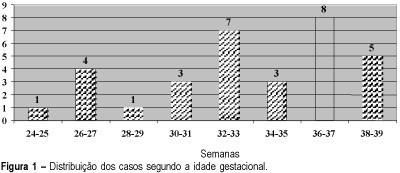Summary
Revista Brasileira de Ginecologia e Obstetrícia. 2001;23(10):659-665
DOI 10.1590/S0100-72032001001000008
Purpose: evaluation of perinatal outcome of brain-sparing effect detected by color Doppler. Methods: brain-sparing effect was detected in 32 fetuses at the Ultrasound Service of the Center for Integral Attention to Women's Health at Campinas State University (UNICAMP). The diagnosis of brain-sparing effect was made when the ratio between middle cerebral artery and umbilical artery pulsatility indexes was below one (IPACM/IPAU <1). The measurement was obtained with color Doppler equipment Toshiba SSH-140A. Results: admission to neonatal intensive care unit (ICU) was necessary in 26 fetuses (89.6%). The number of days in ICU varied from 1 to 83 days, with a mean of 22 days. Fetal mortality rate was 3 in 32 (9.4%) and perinatal mortality was 9 in 29 (31%). Considering the gestational age by the Capurro method, the incidence of birth below 36 weeks was 21 in 32 (65.6%). Intrauterine growth restriction occurred in 71.8% of the cases and hypoglycemia in 44.8%. Conclusions: brain-sparing effect is a condition in which the fetus is at serious risk of adverse perinatal outcome and Doppler studies might be helpful in the obstetric management.
